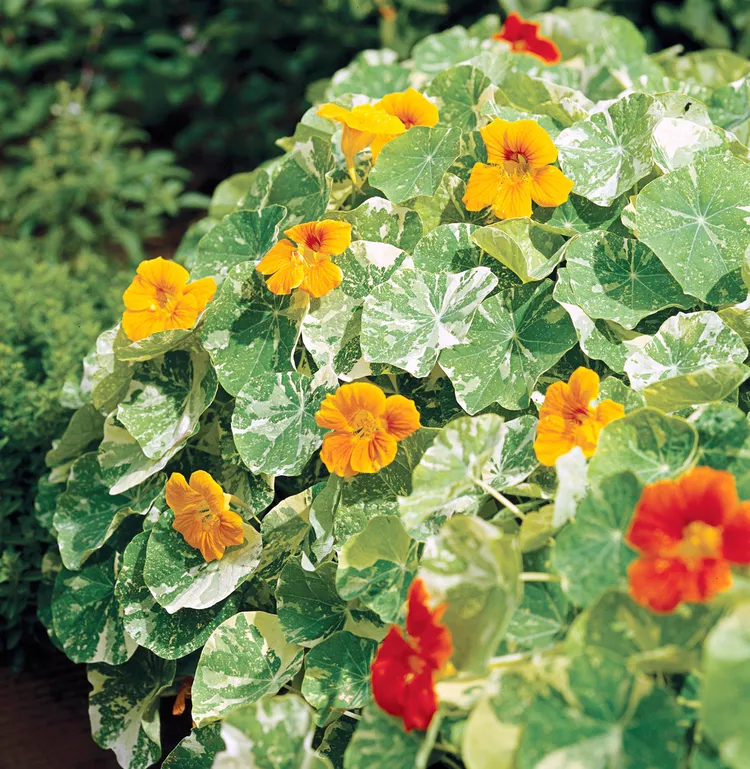10 Best Potato Companion Plants to Keep Pests Away

Choosing the right potato companion plants can help protect your crop from common pests, such as the Colorado potato beetle, aphids, and cutworms. Several herbs, vegetables, and flowering plants can help keep your tubers growing strong and pest-free without resorting to toxic pesticides. Below, you'll find some of the best potato companion plants, along with essential tips for maximizing your potato harvest with the help of these plants.
Sweet Alyssum
Sweet alyssum is a low-growing, flowering, pretty annual known for its petite white and purple flowers. It’s also one of the best potato companion plants. Alyssum blooms attract beneficial insects, including hoverflies and ladybugs, which can keep unwanted potato pests in check. When used as a groundcover, alyssum also helps lock in soil moisture and prevent weeds, which will help your potatoes grow larger and more vigorous.
Cabbage Family Members
Broccoli, cauliflower, kale, and other related plants have short root systems that won’t compete with your potatoes for valuable soil space. Pairing these two types of plants together will help you to get the most out of your garden beds. Just keep in mind that these plants are heavy feeders, so they should be fertilized regularly with a well-balanced fertilizer to ensure your veggies get all the nutrients they need.
Horseradish
Horseradish isn't as commonly grown among backyard gardeners as some other vegetables, but it makes a fine condiment and an even better potato companion plant. Its large, oversized leaves help shield the soil around your potatoes, preventing weeds and conserving soil moisture. What's more, horseradish appears to repel the destructive Colorado potato beetle and may boost potatoes' natural ability to resist disease. However, it can spread aggressively, so it's best to plant horseradish where you can keep it contained.
Alliums
Chives, leeks, onions, and other alliums are some of the best plants to grow for natural pest control. Their pungent aroma repels many garden pests, including aphids and beetles. Once it’s time to harvest, you’ll be even happier you added these as potato companion plants, as you’ll have all the ingredients for a mouth-watering potato and leek soup.
Cilantro
Cilantro makes an excellent potato companion plant, especially when allowed to flower. In bloom, this plant attracts hoverflies, lacewings, ladybugs, and parasitic wasps to your garden. These insects, in turn, prey on common potato pests, including Colorado potato beetle grubs and aphids.
Nasturtium
Nasturtium is an attractive plant generally grown for its looks or harvested for its edible flowers and peppery-tasting leaves. But nasturtium is also a prime potato companion plant for natural pest control, as it helps keep several troublesome insects in check. Nasturtiums often act as “trap crops,” luring pests like aphids and Colorado potato beetles away from potatoes so they are easier to contain and eliminate.
Beans and Peas
Beans and peas won’t compete with your potatoes for garden space or nutrients, so you won’t need to worry about these plants stunting your potato harvest. But more than that, legumes’ natural nitrogen-fixing ability provides valuable nutrients to the soil. Legumes can help you grow lusher and more abundant plants when planted with your potatoes.
Beyond this, beans can also repel Colorado potato beetles. In return, potatoes keep Mexican bean beetles away, which can otherwise devastate your bean plants.
Sage
Sage is an aromatic herb ideal for attracting bees and other pollinators to your garden. Its strong scent is also well-known as a deterrent for flea beetles and other common pests. And if you needed more reasons to grow sage with your potatoes, sage and potato gnocchi are hard to beat on a cozy night in.
Lettuce
Potatoes can take months to mature in the garden, using valuable garden space. However, if you pair your slow-growing potatoes with faster-growing plants, like lettuce and other leafy greens, you can get much more food out of your vegetable garden. Adding lettuce as a potato companion plant is a smart way to use your garden space, and undemanding lettuce won’t compete with potatoes for nutrients, either.
Marigolds
Keeping marigolds in your organic garden is one of the best ways to prevent pests naturally. Marigolds’ scent is naturally repellent to many common pests, including Colorado potato beetles. Sowing marigolds among your tubers will help keep your plants naturally pest-free, plus the marigold flowers will provide some bright color to liven up your garden beds.